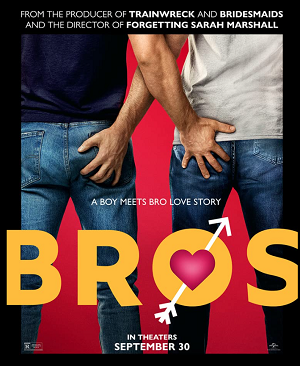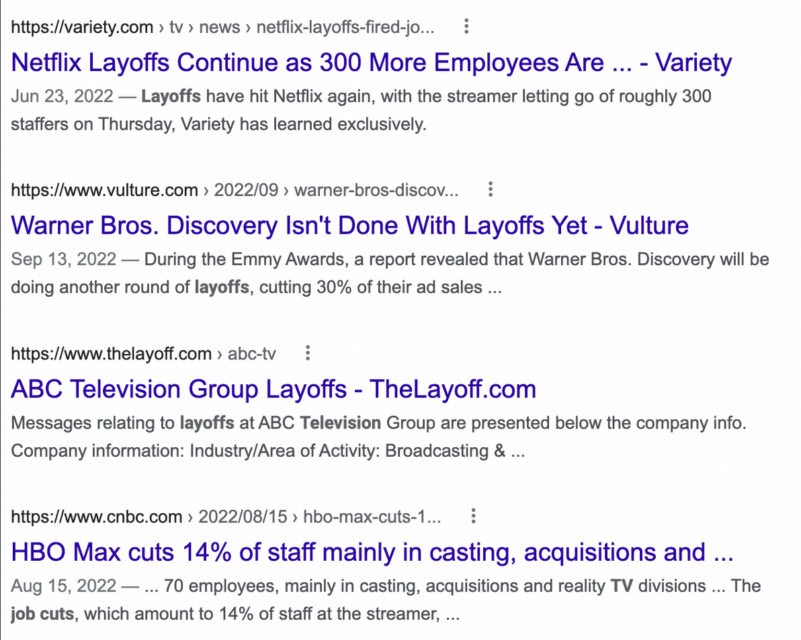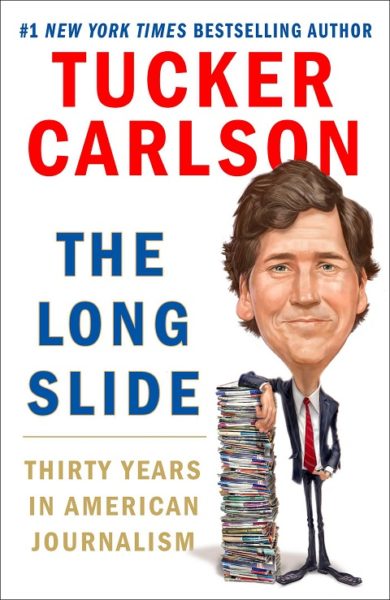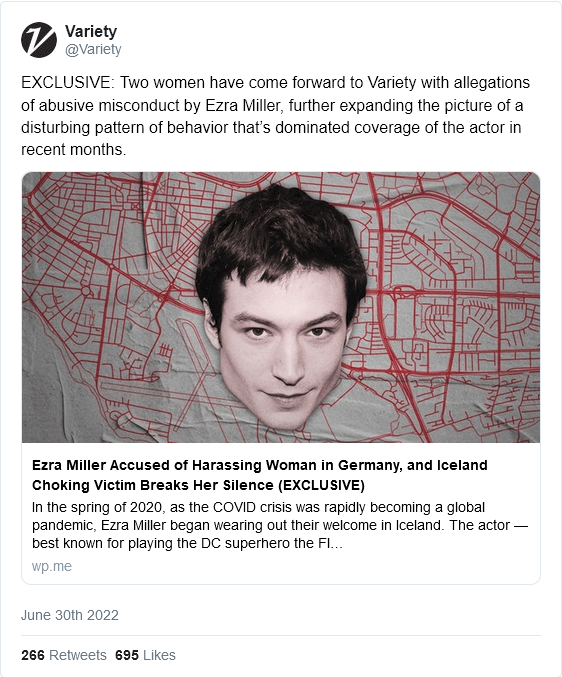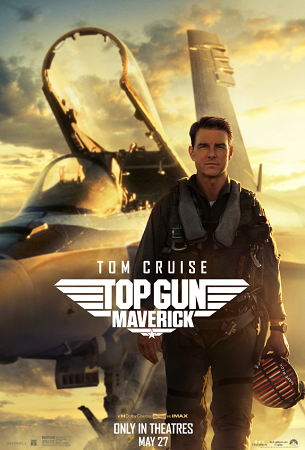World War Two
Published 9 Nov 2022The genocide of the Jews of Eastern Europe concludes with Operation Harvest Festival — Aktion Erntefest when 42,000 are murdered in the Lublin district.
(more…)
November 12, 2022
The Final Bloody Chapter of Operation Reinhard – War Against Humanity 085
November 10, 2022
Contemplating the end of brand franchises like Star Wars
Ted Gioia is wondering how Star Wars ends:
Lately, I’ve been wondering how Star Wars ends.
Let me be clear, I’m not worried about how the story resolves, or what happens to the characters. I have zero interest in all that. Darth Vader can win the Nobel Peace Prize, for all I care.
I’m more concerned with how a powerful brand franchise loses its stranglehold on the culture. And it’s not just Star Wars, it’s all those other stories that never achieve closure. I’m talking about Batman and Indiana Jones and James Bond and the Marvel Cinematic Universe (or MCU, for short), and the rest of them.
They all die, sooner or later. But how?
Heroes in capes and colorful costumes seem invincible now, if only because these fictional flâneurs are bigger than anything else in commercial culture. If Spiderman and Batman were real people, they would boast higher incomes and net worth than any flesh-and-blood entertainer in the world. The Marvel Cinematic Universe, which Disney acquired back in 2009, must be worth ten or twenty times the $4 billion they spent back then — total revenues from Marvel brands since then are somewhere around the one trillion dollar mark.
No pop star in history has ever possessed that kind of earning power.
Can these franchises just go on forever? The management team at Disney certainly must hope so, judging by their never-ending slate of Star Wars, Marvel, and other brand extension offerings. No Time to Die isn’t just the name of the 25th James Bond movie, but a promise for the future — why not another 25 films in the series? Or 50 or 100?
But brand franchises do die, or become so tired that few people care anymore. Universal Studios made so much money from Ma and Pa Kettle films that these corny comedies allegedly saved it from bankruptcy in the 1940s, but by 1960 audiences had lost interest in the predictable formulas of the series.
The Carry On films were the most dependable audience draw in British comedy, but after 31 movies the franchise could carry on no longer. A final resuscitation attempt after 14 years not only failed at the box office but was voted the worst British film ever made.
Some franchises not only die, but become genuinely toxic as attitudes evolve — killing, for example, the Charlie Chan franchise, and making it unlikely that Tarzan or the Lone Ranger or many other once lucrative brands will ever enjoy another meaningful payday.
None of this should surprise us, because narratives and protagonists go in and out of fashion like anything else. A story that charmed your grandparents is unlikely to interest your grandchildren.
October 30, 2022
Jatimatic: Finland’s Least Successful PDW
Forgotten Weapons
Published 24 Jun 2022The Jatimatic was a stockless PDW designed by Jari Timari, who co-owned Tampereen Asepaja Oy, a firearms company in Tampere Finland. The firm was founded in the early 1920s, making .22 biathlon rifles, sporterizing military surplus, and other gunsmithing work. In the late 70s he got the idea for a compact 9mm PDW with some unique climb-reducing features, and in 1980 it was introduced as the Jatimatic (JAli TImari). Only about 400 were made, as it was not adopted or purchased in large quantities by anyone (although it was tested by many, including the Finnish Border Guards).
The Jatimatic was made without a stock, instead using a shooting sling for stabilization. It used standard Swedish K magazines, and has a distinctly off-angle appearance. This was done to counteract muzzle climb, as the line of the barrel points directly back into the shooter’s hand. It also has an interesting safety built into the folding front grip – if the grip is closed, the bolt is locked in place.
Production ended in the late 1980s after “permit irregularities” and a robbery of a bunch of Jatimatics from the company premises. The rights to the design were sold to a new company called Golden Gun in 1994, and they attempted to reintroduce it as the GG-95 with a few improvements, but it was a rather complete flop. Its best achievement was getting into several major movies, including Cobra and Red Dawn.
(more…)
October 14, 2022
The commercial failure of Bros
With the movie failing to find much of an audience, the director and lead actor blame homophobia, because that’s far easier than accepting that rom-com movies are quaint, out-of-date, and stale in the modern hookup culture:
In the case of movies, one might respond to Stoller and Eichner by saying that entertainers are supposed to provide products that the viewing public wishes to see. It might surprise the team behind the didactic Bros that many of us watch movies to be entertained, not to be preached at, seeing them as brief, trivial moments of escape from the drudge of daily life, not an opportunity to (as the Victorians would have said) “improve” ourselves. But even though it has proved an abject commercial failure, the movie is nonetheless instructive in how our culture is changing. And both its production values and its failure are likely signs not of the LGBTQ movement’s influence stalling, but of its remarkable success.
[…]
Romance depends upon sex being costly. It was the difficulty of obtaining sex, the need for that delicate, complicated, and unpredictable interpersonal dance between two people, that was the very essence of what it was to be romantic. In a world where sex is not simply casual but remarkably cheap, the notion of romance is dead. Romance requires a particular kind of culture in order to make sense. A world of hookups, one-night stands, and all-pervasive pornography is not one that gives people the cultural grammar and syntax to understand it. That the movie apparently contains scenes of sex and nudity is hardly exceptional today. But that’s the point: A world where sex and nudity are displayed on the screen is not a world where romance has any place. Just as explicit rap lyrics reflect a world antithetical to that in which Frank Sinatra sang “Fly me to the moon”, so the endless tedium of explicit sex on celluloid is not that of Audrey Hepburn and Fred Astaire in Funny Face. Romance depends upon social codes of restraint and modesty, and upon the idea that sex is not something casual but something special, even sacred.
The same point can be made with reference to what we might call romantic tragedy. Take Tolstoy’s Anna Karenina. The story simply could not be set in modern America because Anna, married to the tedious Karenin but falling in love with the dashing Vronsky, would simply file for divorce and move out of Karenin’s house and into that of her lover. The tragic romance is rooted in the impossibility of Anna’s situation, given the way sex is seen through the powerful moral lens of nineteenth-century Russian society. The genre of romantic tragedy depends upon a specific moral framework. So does the genre of romantic comedy. But the sexual revolution has obliterated that moral framework.
To return to Bros, it is frankly as ridiculous to make a rom-com in the twenty-first century as it is to hire a cast and crew on the basis of modern categories of identity rather than professional competence. And, while the Bros team might regard its box office failure as discouraging, it might just as easily be evidence of the triumph of the LGBTQ movement in wider society as it is of a residual resistance to the same. Please don’t blame homophobia for your commercial failure. Romance is dead. And you helped to kill it.
September 26, 2022
Did D-Day win WW2? – a WW2 expert discussion
World War Two
Published 25 Sep 2022WW2 historians Indy Neidell, Spartacus Olsson, and Paul Woodadge moderated by Ryan Socash discuss the meaning and significance of D-Day from historical, current, and future perspectives. Recorded on the road while shooting in Normandy for TimeGhost’s 24-hour documentary on the events of June 6, 1944.
(more…)
September 24, 2022
September 13, 2022
Society would be happier if we all paid even less attention to “the tossers of Tinsel Town”
Ian O’Doherty on the malign influence pretty people who mouth other people’s words for the cameras still exude in our popular culture:
They never learn, do they? If the tumultuous events we have all watched with growing horror over the past few years taught us one thing, it is this – people don’t care what the pampered starlets of Hollywood have to say about politics. If we did, then Hillary Clinton would be comfortably enjoying her second term as the pantsuit POTUS, Jeremy Corbyn would be prime minister of the UK and we would all be driving electric cars.
But regular people are smarter than actors, which seems to drive the luvvies wild with fury. Rather than accepting that maybe, just maybe, there is another side to the argument, the tossers of Tinsel Town insist that anyone who doesn’t fully embrace the so-called progressive agenda is simply a monster.
We saw this recently when Jennifer Lawrence, who used to be quite refreshingly down to Earth, proudly admitted that she had to “work so hard … to forgive my dad and my family” for voting Republican. She also, quite wonderfully, spoke about having “recurring nightmares” about Fox News anchor Tucker Carlson.
In the course of her interview for the cover issue of Vogue magazine – that renowned bastion of proletarian agitation – the Hunger Games actress claimed that she was born a Kentucky Republican, was raised as a Kentucky Republican and had considered herself to be a Kentucky Republican, until she watched an episode of 30 Rock. And then her worldview completely changed.
Now most of us would agree that 30 Rock was a brilliant sitcom. After all, it was so ingenious in its construction that it even managed to make Alec Baldwin look likeable. But would anyone think that Liz Lemon’s line, “I’m not a crazy liberal – I just think people should drive hybrid cars”, would be enough to utterly transform someone’s political beliefs?
Apparently, this is what changed everything for Lawrence. She even seemed proud of the fact that a throwaway line in a sitcom triggered some sort of Damascene conversion to what is now so tediously known as “the right side of history”.
Predictably, following the Vogue interview, Lawrence was hailed as a modern-day Joan of Arc – for refusing to be “passive about politics”. But there is no real bravery involved in simply having the courage of other people’s convictions – she knows which way the political wind is blowing and is bending to it. That’s not all that brave, is it?
September 12, 2022
The Lord of the Rings and Ancient Rome (with Bret Devereaux)
toldinstone
Published 10 Sep 2022In this episode, Dr. Bret Devereaux (the blogger behind “A Collection of Unmitigated Pedantry”) discusses the relationships between fantasy and ancient history – and why historical accuracy matters, even in fiction.
(more…)
August 19, 2022
How Accurate is Saving Private Ryan? – WW2 D-Day Special
World War Two
Published 16 Aug 2022How accurate is that famous beach scene in Saving Private Ryan? Is it true to the history or just another Hollywood story? Seeing as we’re about to start the filming for our massive D-Day project, we figured we’d break it down, shot by shot.
(more…)
August 4, 2022
QotD: Errol Flynn versus Basil Rathbone in the 1938 Adventures of Robin Hood
A lot of swordfighting in medieval-period movies is even less appropriate if you know what the affordances of period weapons were. The classic Errol Flynn vs. Basil Rathbone duel scene from the 1938 Adventures of Robin Hood, for example. They’re using light versions of medieval swords that are reasonably period for the late 1100s, but the footwork and stances and tempo are all French high line, albeit disguised with a bunch of stagey slashing moves. And Rathbone gets finished off with an epée (smallsword) thrust executed in perfect form.
It was perfect form because back in those days acting schools taught their students how to fence. It was considered good for strength, grace, and deportment; besides, one might need it for the odd Shakespeare production. French high-line because in the U.S. and Europe that was what there were instructors for; today’s Western sword revival was still most of a century in the future.
This scene exemplifies why I find the ubiquitousness of French high-line so annoying. It’s because that form, adapted for light thrusting weapons, produces a movement language that doesn’t fit heavier weapons designed to slash and chop as well as thrust. If you’re looking with a swordsman’s eye you can see this in that Robin Hood fight. Yes, the choreographer can paste in big sweeping cuts, and they did, but they look too much like exactly what they are – theatrical flourishes disconnected from the part that is actually fighting technique. When Flynn finishes with his genuine fencer’s lunge (not a period move) he looks both competent and relieved, as though he’s glad to be done with the flummery that preceded it.
At least Flynn and Rathbone had some idea what they were doing. After their time teaching actors to fence went out of fashion and the quality of cinematic sword choreography nosedived. The fights during the brief vogue for sword-and-sandal movies, 1958 to 1965 or so, were particularly awful. Not quite as bad, but all too representative, was the 1973 Three Musketeers: The Queen’s Diamonds, a gigantic snoozefest populated with slapdash, perfunctory swordfights that were on the whole so devoid of interest and authenticity that even liberal display of Raquel Welch’s figure could not salvage the mess. When matters began to improve again in the 1980s the impetus came from Asian martial-arts movies.
Eric S. Raymond, “A martial artist looks at swordfighting in the movies”, Armed and Dangerous, 2019-01-13.
July 21, 2022
The Railrodder (1965)
NFB
Published 15 May 2015This short film from director Gerald Potterton (Heavy Metal) stars Buster Keaton in one of the last films of his long career. As “the railrodder”, Keaton crosses Canada from east to west on a railway track speeder. True to Keaton’s genre, the film is full of sight gags as our protagonist putt-putts his way to British Columbia. Not a word is spoken throughout, and Keaton is as spry and ingenious at fetching laughs as he was in the old days of the silent slapsticks.
Directed by Gerald Potterton – 1965
July 10, 2022
QotD: The difference between courage and fearlessness
Grrl power is based on wanting girls to be courageous. But the writers who do the scripts for grrl power movies seem to have have a fundamental misunderstanding of courage. Courage does not mean not being afraid of anything. I was watching the live-action reboot of Disney’s Beauty and the Beast and I really got tired of the heroine, who kept saying “I’m not afraid” over and over, even in situations where she really ought to be afraid. That’s not courage, that’s foolhardiness. Like that stupid “fearless girl” sculpture they put in front of the charging bull on Wall Street. Within about 5 seconds, the girl is going to be dying from massive internal injuries caused by horns and hooves. No, courage means being able to put aside your fear so that you can do whatever duty is required of you. “Fearless girl” isn’t really doing anything, she’s just striking a pose. That doesn’t mean girls can’t be brave. They certainly can be. You know who I think is a good example of grrl power? Dorothy Gale. You know, the character played by Judy Garland in the classic Wizard of Oz film. I don’t know about the character in the book, but in the film version, Dorothy spent most of the journey through Oz scared to death. But do you know what? She slapped a dangerous lion in the snout. She threw water on a witch. And she called out a wizard with god-like powers for being a lying sh*tweasel. She was not any less afraid, but but she did what was needed to be done at the time she needed to act. That’s courage. That’s grrl power. And she didn’t just stand there striking a pose.
OregonMuse, “The Morning Rant”, Ace of Spades H.Q., 2019-03-16.
July 2, 2022
The “preferred pronoun” problem
Jim Treacher is having pronoun problems … not choosing the ones he wants to use or for others to use for him, but the whole “preferred pronoun” imposition on the rest of society to learn, remember, and use properly the bespoke pronoun choices for all the extra, extra-special snowflakes:
Remember when you could just use the pronouns that self-evidently described a person? If you were talking about a fella, you’d say stuff like, “He did this” and “Here’s what I said to him.” Or if you were talking about a lady, you’d say things like, “The 19th Amendment says she can vote now, good for her.” It was a simpler time.
Now pronouns are a frickin’ minefield. You put one little tippy-toe on the wrong pronoun and … BOOM!! A heedless “misgendering” can get you in big trouble. You can get banned from the internet and/or lose your job. For some reason, you’re expected to enable the delusions of any person with trendy mental health issues. It’s not enough for a trans person to call him-, her-, or themselves whatever he, she, or they want. The rest of us are all obligated to go along.
Even if he’s a scumbag criminal like Ezra Miller.
And what’s even worse, this bizarre phenomenon renders news stories about “nonbinary” people almost indecipherable. Just look at this latest story about the ex-Flash actor going around the world being a violent lunatic:
The actor — best known for playing the DC superhero the Flash in several films for Warner Bros. — was set to start filming the studio’s latest entry in the “Harry Potter” franchise, Fantastic Beasts: The Secrets of Dumbledore, in London when the shoot was halted on March 15, 2020, due to COVID. In the weeks after, Miller, who identifies as nonbinary and uses “they/them” pronouns, became a regular at bars in Iceland’s capital, Reykjavík, where locals came to know and even befriend them. Many recognized Miller from their earliest breakout movies, 2012’s The Perks of Being a Wallflower and 2011’s We Need to Talk About Kevin, where they played a troubled teen who brought a bow and arrow to school and murdered his classmates.
It’s a grammatical nightmare. “Many recognized Miller from their earliest breakout movies.” Oh, so those Icelanders worked with Miller on those movies? No, you see, “their” is supposed to refer to him.
And this part is just madness: “They played a troubled teen who brought a bow and arrow to school and murdered his classmates.” So it’s not “They murdered their classmates,” because the character he was playing wasn’t nonbinary? What is this gibberish?
Tom Hanks recently said he regrets playing a gay man in Philadelphia because he’s not gay. I always thought that was just called “acting”, but what do I know. If that’s the case, though, why should a nonbinary person be allowed to play a normal person?
June 18, 2022
June 16, 2022
Paul Wells takes in a current movie … and likes it
I’ve never been much of a movie-goer, even before the neverending pandemic lockdown theatre landed on us in 2020, so the chances of me going to see something like Top Gun: Maverick were pretty low (especially as I never bothered to watch the original, back in the day). Paul Wells is in the middle of a European trip, so he did what every travelling North American would do somewhere on the continent of history and culture: he watched a current-release American movie:
The mystery of Maverick is why, by next weekend, it will pass Doctor Strange in the Convolution of Fan Service as the year’s biggest movie, why it is the biggest film of Tom Cruise’s charmed life — why it strikes such a chord in this moment, even though its premises, visual vocabulary and soundtrack are 36 years old. In terms of chronological distance from the original Top Gun, it’s as though the top-grossing movie of 1986 had been a sequel to 1950’s Annie Get Your Gun. (“And there has never been a star as sensational as Betty Hutton!” Annie‘s trailer proclaims. Switch Tom Cruise in for poor Betty and suddenly the claim may actually be true.)
The simplest hypothesis is that Maverick is just big and loud, so you can leave your brain at home and enjoy the spectacle. But lots of lousy movies nobody watched were big and loud, including Matrix: Resolutions and Ghostbusters: Afterlife, so there must be some fuller explanation.
This being a Substack newsletter, I suspect I’m contractually encouraged to argue that Maverick wins because it isn’t woke. I’m afraid I can’t oblige. I mean, the movie definitely makes only the barest acknowledgment of taking place in the 21st century. None of the hotshot young recruits pauses from the action to specify their pronouns. None decorates their flight helmets with empty square brackets to acknowledge their privilege. The film’s few concessions to cultural change since the MTV era have the effect, not of engaging today’s fights on provocatively old-fashioned terms, but of declining to engage. Joseph Kosinski, the journeyman special-effects technician brought in to direct this film in note-perfect homage to the style of the original Top Gun director Tony Scott, doesn’t even bother to make the film’s racial politics as minimally complex as Scott did in 1995’s Crimson Tide. Maverick‘s young recruits, diverse in gender and ethnicity, are awesomely interchangeable in every other way. One smirks, one has a moustache; the others have no identifying characteristics. (When half the recruits get cut from the big mission at the 90-minute mark, there is no dramatic payoff because it’s impossible to tell these people apart. “Sorry, Component A, I’ve decided to go with Component B.”) Nobody under 30 in this film has sex for either pleasure or procreation. Yearning for intimate touch is plainly something only old people do, like writing in cursive script or owning books.
As a cultural argument, Maverick is so close to being tabula rasa that there’s no real point interrogating it. But on another front, it succeeds resoundingly in popular art’s primary function of tantalizing simplification. It started to make sense when I realized that Cruise’s character, despite the denial inherent in his call sign, is a career civil servant.
This is a movie about the action of a large modern state. It’s a film about public policy. Its central claim is a cathartic feat of Avengers-level denial. Just as the superhero movies offer us a made-up universe in which we have any hope of telling the good characters and the evil characters apart, Maverick posits a world in which modern governments can get anything done at all.
I may be influenced in this reading by the fact that I work in contemporary Ottawa. I’ve been writing variations on a simple question — Can Justin Trudeau get big things built? — since 2017. I’m hardly alone. And it’s hardly just a question about Trudeau, Ottawa or Canada. It’s been fun reading about chaos at Toronto’s Pearson airport, but last week the Financial Times ran a “big read” feature story about global airport chaos that didn’t even mention Pearson, Toronto or Canada. Joe Biden promised to Build Back Better. It’s not going great. Here in France, Emmanuel Macron is the first president to be re-elected in 20 years, a genuine feat, but it’s not going great. Brexit? Don’t ask.
A generic term for the ability of governments to do stuff is “state capacity”, and there’s a vague sense in the quasi-academic literature that it’s in decline, although, the real world being the real world, every element of this claim — that state capacity is declining, that it can be measured, that it even exists in any measurable form — is open to dispute. Still, it feels true, don’t it? The world was never great. In important ways it was worse than today. But it used to feel like it was possible to improve the thing, and now it just feels like everyone’s just firing blind and hoping for the best. COVID is a dynamite demonstration of this. Three successive Canadian federal health ministers were told, by a prime minister who prides himself on his ability to read the room, to get cracking on plain-paper packaging for tobacco products. And then the biggest public-health disaster of our lifetimes opened up its jumbo can of whup-ass, and it wasn’t even in the mandate letters. And it’s hard to blame anyone involved. All the chaos that has ensued had its roots in the original chaos. Real life doesn’t have a plot. As Homer Simpson said, it’s just a bunch of stuff that happens.


